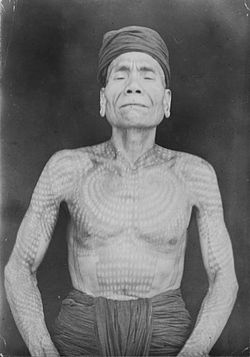 Portrait of a tattood Ot Danum Dayak man from the Kahajan region of Central Borneo, circa 1898–1900. | |
| Total population | |
|---|---|
| 94,000 [1][ unreliable source?] | |
| Regions with significant populations | |
| Languages | |
| Ot Danum, Indonesian | |
| Religion | |
| Christianity ( Protestant & Roman Catholic) 51%, Kaharingan 38%, Islam ( Sunni) 11% [2] | |
| Related ethnic groups | |
| Dusun, Lawangan, Ma'anyan, Ngaju |
Ot Danum (also known as Dohoi, Malahoi, Uud Danum or Uut Danum) people are an ethnicity of the Dayak peoples (hence also referred as Dayak Ot Danum)[ citation needed] dwelling at the upper reaches of south Kapuas River, and along the Schwaner range, bordering West Kalimantan and Central Kalimantan, Indonesia. [3] They are the most important group of the upper Melawi River and culturally and linguistically the most distinct from the Malay people. [4] Besides, the Malay people, the Ot Danum people are also linguistically distinct from the Ngaju people who live along the middle reaches of Central Kalimantan's great rivers and who are numerically and linguistically the dominant Dayak people group in the area. [5] Just like most Dayak people group, majority of the Ot Danum people also practice Kaharingan religion. [6]
The word Ot means people or upstream, while the word Danum means water. Therefore, the name Ot Danum means "water people" or "upriver people" or "people who live at the upstream river". [7] The Ot Danum people are closely tied to living with nature and would revere the traditions of their ancestors by taking care of the balance between mankind and the surrounding nature.
References
- ^ "Dohoi Ot Danum in Indonesia". Joshua Project. Retrieved 2014-09-27.
- ^ Chalmers, Ian (2006). "The Dynamics of Conversion: The Islamisation of the Dayak Peoples of Central Kalimantan". In Vickers, A.; Hanlon, M. (eds.). Proceedings of the 16th Biennial Conference of the Asian Studies Association of Australia (ASAA): Asia Reconstructed, Jun 26–29 2006. Wollongong, NSW: Australian National University. hdl: 20.500.11937/35283.
- ^ "Ot Danum". Ethnologue. Retrieved 2014-09-27.
- ^ Borneo Research Council (Williamsburg, Va.) (1986). Borneo Research Bulletin, Volumes 18-20. Borneo Research Council.
- ^ John F. McCarthy (2001). Decentralisation and Forest Management in Kapuas District, Central Kalimantan. CIFOR. ISBN 979-8764-80-3.
- ^ Rosana Waterson (2009). Paths and Rivers: Sa'dan Toraja Society in Transformation. BRILL. ISBN 978-90-04-25385-8.
- ^ Frank M. LeBar & George N. Appell (1972). Ethnic Groups of Insular Southeast Asia: Indonesia, Andaman Islands, and Madagascar. Human Relations Area Files Press. ISBN 978-0-87536-403-2.